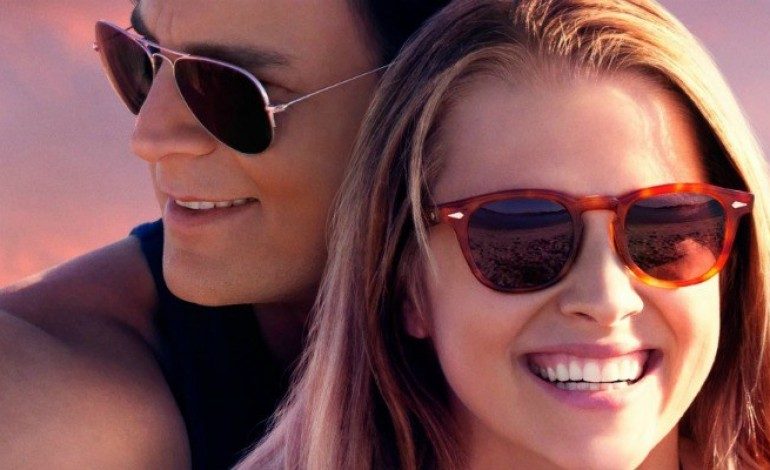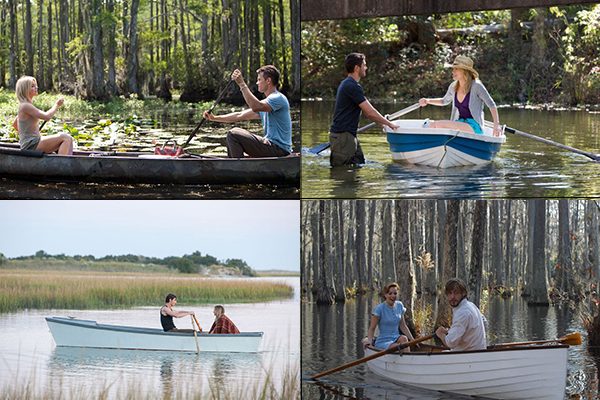

With the impending release of The Choice this weekend, the 11th film adaptation of a Nicholas Sparks novel in the past 17 years, I thought I would take an in-depth look at what exactly keeps audiences (shamelessly including myself) coming back for more. A new Sparks adaptation has become as common and expected as a yearly Woody Allen film – in fact, beginning in 2012 with The Lucky One, it has now become an annual occurrence. As someone who has personally sat down and watched every single one of these films, they have unfolded over the beginning of the 21st century to become a genre in and of themselves and seem to have survived on a specific plot formula. Moving forward, I will be exploring this romantic procedure and suggesting why it continues to draw in audiences and the areas where it could potentially improve upon in the future.
First, let’s take a quick look at the lineup of films:
Beginning with 1999’s Message in a Bottle and ending with 2016’s The Choice, the one-sheets themselves have followed two specific image patterns: the first being the hug from the back and the second being the emotionally fraught embrace just before the kiss (a particular favorite in Hollywood). The only poster that seems to slightly deviate is The Longest Ride, which was ironically one of the more sexually charged films in the entire filmography. The remaining films include A Walk to Remember, The Notebook, Nights in Rodanthe, Dear John, The Last Song, The Lucky One, Safe Haven, and The Best of Me.
Digging deeper into each plot, I’ve concocted a rough formula that each story follows in one form or another. The recipe for each romance contains (almost always) the following:
1. A young boy and girl: “Young” is a relative term, but can mean any age from 16 to about 30. The romance can often extend past these ages, but the young love aspect nearly always starts the story off. Films in which this occurs: All, except Message in a Bottle and Nights in Rodanthe.
2. An obstacle in the way of them falling in love: This often manifests in an emotional obstacle (mourning a previous tragedy, being closed off, stubbornness, shyness, etc.), but can also take the form of unapproving parents, differing social circles, or differing social classes. Sometimes, the obstacle is simply a general dislike for one another. Films in which this occurs: All.
3. A serious tragedy: From dementia, to car crashes, cancer, death, or a past tragedy that casts a long shadow, every single one of these films sees its two love birds facing a deep and life threatening struggle. This sometimes takes form in a family member, but it is always a defining factor in the future of the relationship. Films in which this occurs: All.
4. A North Carolina setting: Since it is the state in which Nicholas Sparks grew up, it is not much of a surprise that he would place his stories all in a small North Carolina seaside town. This setting not only provides a personal connection to the author, but also a quiet romantic backdrop for the story where the relationship can pull focus from its small-town surroundings (as well as include what seems to be Sparks’ favorite pastime, boating). Films in which this occurs: All.
5. A romance epic in scale: Something that all of these cinematic relationships have in common is the intense and life-changing impact that the love produces and struggles past. The romances span lifetimes and long distances, heal personal tragedies, and never end in a break-up. Sparks wouldn’t dare write a story in which the two lovers are anything less than “the one” for each other. Films in which this occurs: All.
Seeing as how each and every single one of these films are nearly identical in plot, why do we continue to care? Don’t get me wrong, I am sure that there are a great many moviegoers that have written off these films entirely at this point, but regardless, they continue to get made and experience a high box office demand. One reason for this could be its universal themes. Many of us dream of having a similarly life-shattering type of love (momentarily suspending the argument about whether or not this desire is based on reality), and need some positive reinforcement that this kind of love exists. It is also possible that in essentially creating his own romantic genre, Sparks has tapped into an infinite well of formulaic entertainment — it is no secret that other genres like buddy comedies, courtroom dramas, assassin and heist films as well as many, many others have thrived throughout the years based on the foundations of their single plot structures.
Another major selling point could be the stars of the films themselves. Sparks adaptations have nearly always been treated as launching pads for young up-and-comers (i.e. Mandy Moore, Rachel McAdams, Ryan Gosling, Britt Robertson, Scott Eastwood, Channing Tatum, Liam Hemsworth, Julianne Hough, Teresa Palmer, Taylor Schilling, etc.), or a platform for tried and true romantic leads (i.e. Richard Gere, Kevin Costner, Amanda Seyfried, Josh Duhamel, James Marsden) or even a re-launching pad for famous actors like Zac Efron or Miley Cyrus (fun fact: Sparks actually wrote The Last Song specifically for Cyrus in her post-Hannah Montana career).


Outdoor cuddling featured in ‘Message in a Bottle’, ‘A Walk to Remember’, ‘Dear John’, and ‘The Longest Ride’
From my perspective, the fact alone that these films are based on a standardized romantic plot and as a platform for new actors gives these adaptations a ripe opportunity to begin affecting change within Hollywood. This is related to another striking similarity within each movie and the giant elephant in the room which is the case that the leads have all been played by white actors and have followed heteronormative story lines. Any of these characters could be played by a minority actor and many story lines could be written for differing sexualities and genders. It is almost a wonder that casting directors have not picked up on this point (almost). This would be a collective call to action for the filmmakers, casting directors, studio heads, and Sparks himself to make these films truly universal by featuring all kinds of faces and all kinds of love. The story line and the plot formula can stay the same for all they want, but let’s face it, not only beautiful white, heterosexual couples are falling in love in North Carolina.
The fact of the matter, however, is that Nicholas Sparks is pretty much in a league of his own. Other authors are beginning to emerge in similar capacities, such as John Green and his slew of teen romance adaptations (The Fault in Our Stars, Paper Towns, and the in-development projects Looking for Alaska and Let it Snow), or Matthew Quick (Silver Linings Playbook, and the in-development projects Forgive Me, Leonard Peacock, Every Exquisite Thing, Love May Fail, and Boy21). None have yet tapped the market as fully as Sparks, though, and with The Choice likely heading for a decent run at the theaters this month, I don’t see that changing any time soon.


